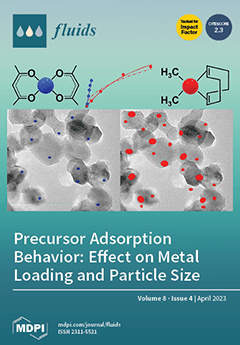This paper aims to develop models for the thermal conductivity and viscosity of hybrid nanofluids of aluminium oxide and titanium dioxide (Al
2O
3-TiO
2). The study investigates the impact of fluid temperature (283 K–298 K) on the performance of
[...] Read more.
This paper aims to develop models for the thermal conductivity and viscosity of hybrid nanofluids of aluminium oxide and titanium dioxide (Al
2O
3-TiO
2). The study investigates the impact of fluid temperature (283 K–298 K) on the performance of a plate heat exchanger using Al
2O
3-TiO
2 hybrid nanofluids with different particle volume ratios (0:5, 1:4, 2:3, 3:2, 4:1, and 5:0) prepared with a 0.1% concentration in deionised water. Experimental evaluations were conducted to assess the heat transfer rate, Nusselt number, heat transfer coefficient, Prandtl number, pressure drop, and performance index. Due to the lower thermal conductivity of TiO
2 nanoparticles compared to Al
2O
3, a rise in the TiO
2 ratio decreased the heat transfer coefficient, Nusselt number, and heat transfer rate. Inlet temperature was found to decrease pressure drop and performance index. The Al
2O
3 (5:0) nanofluid demonstrated the maximum enhancement of around 16.9%, 16.9%, 3.44%, and 3.41% for the heat transfer coefficient, Nusselt number, heat transfer rate, and performance index, respectively. Additionally, the TiO
2 (0:5) hybrid nanofluid exhibited enhancements of 0.61% and 2.3% for pressure drop and Prandtl number, respectively. The developed hybrid nanofluids enhanced the performance of the heat exchanger when used as a cold fluid.
Full article





